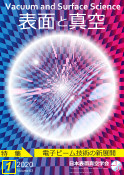63 巻, 12 号
特集「プラズマが誘起する界面反応と表面科学」
選択された号の論文の11件中1~11を表示しています
- |<
- <
- 1
- >
- >|
巻頭言
-
原稿種別: 巻頭言
2020 年 63 巻 12 号 p. 613
発行日: 2020/12/10
公開日: 2020/12/10
PDF形式でダウンロード (352K)
特集「プラズマが誘起する界面反応と表面科学」
-
原稿種別: 企画趣旨
2020 年 63 巻 12 号 p. 614-615
発行日: 2020/12/10
公開日: 2020/12/10
PDF形式でダウンロード (279K) -
原稿種別: 研究紹介
2020 年 63 巻 12 号 p. 616-622
発行日: 2020/12/10
公開日: 2020/12/10
PDF形式でダウンロード (3031K) -
原稿種別: 研究紹介
2020 年 63 巻 12 号 p. 623-628
発行日: 2020/12/10
公開日: 2020/12/10
PDF形式でダウンロード (3502K) -
原稿種別: 研究紹介
2020 年 63 巻 12 号 p. 629-634
発行日: 2020/12/10
公開日: 2020/12/10
PDF形式でダウンロード (1317K) -
原稿種別: 研究紹介
2020 年 63 巻 12 号 p. 635-640
発行日: 2020/12/10
公開日: 2020/12/10
PDF形式でダウンロード (1063K) -
原稿種別: 研究紹介
2020 年 63 巻 12 号 p. 641-648
発行日: 2020/12/10
公開日: 2020/12/10
PDF形式でダウンロード (2722K) -
 原稿種別: 研究紹介
原稿種別: 研究紹介
2020 年 63 巻 12 号 p. 649-655
発行日: 2020/12/10
公開日: 2020/12/10
談話室
-
原稿種別: 談話室
2020 年 63 巻 12 号 p. 656-659
発行日: 2020/12/10
公開日: 2020/12/10
PDF形式でダウンロード (2242K)
海外研究体験記
-
原稿種別: 談話室
2020 年 63 巻 12 号 p. 660-662
発行日: 2020/12/10
公開日: 2020/12/10
PDF形式でダウンロード (1663K)
先端追跡
-
原稿種別: 先端追跡
2020 年 63 巻 12 号 p. 663
発行日: 2020/12/10
公開日: 2020/12/10
PDF形式でダウンロード (319K)
- |<
- <
- 1
- >
- >|






